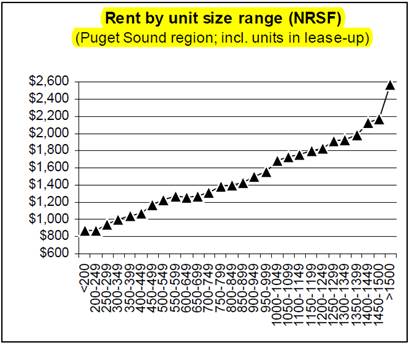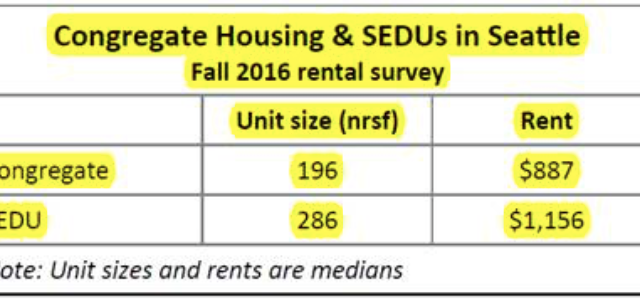Why is Non-Profit Housing So Expensive? Take a Closer Look at Unit Size
We’re waiting for the official release of the Joint Legislative Audit and Review Committee (JLARC) study on why or whether non-profit subsidized housing is more costly to produce than market rate, for-profit housing. Today at Forbes I go on at length about why that is the case. I think the answer may be that market trends favor making units smaller, even one and two bedrooms, in order to get more units on a site. Why? When more units are on a piece of really great land, like in dense places like Capitol Hill or the University District or even Ballard, it means the cost of the land is spread among a greater number of people. It’s just math. I use the analogy of a dinner check. If you have 12 people splitting the check for the same amount of food, the per person price is less than if it were 5 people. When it comes to space, people in the market are willing to make that trade.
But here’s the problem: when you don’t have to worry about how much rent someone is going to pay because there is a limit on that rent, you don’t have to compete. The rent is already set in a non-profit unit. There isn’t, apparently, a way to lower that rent except by fiat from government funders or if more funding is found to offset costs. Market rate developers, contrary to the mythology, want to create lower prices for their product. It’s called competition, and when there is more housing, that means price pressure start doing downward instead of upward. Non-profit developers don’t have people shopping around for their units, instead, they are on years long wait lists. If one opens, it’s like winning the lottery. Imagine if non-profits just made all their units smaller, small enough to boost the number of units on each site.
We know this is how it works. A chart from Dupree + Scott:

I quote David Neiman’s post at Sightline, but it is also worth taking a look at his post here, on Seattle For Growth, to learn more about why unit sizes are trending smaller, especially when land in desirable neighborhoods gets expensive.
Unit size and affordability. At various times we heard skepticism that regulations that raise or lower the size of small apartments make much difference in the rent that people pay. Market survey data shows us otherwise. The figures below are from Dupre & Scott’s Oct 2016 Apartment Advisor Report. The first chart shows a direct linear correlation between unit size and rent. The second chart compares the average rent for the median congregate housing unit vs. the median SEDU. Note that the SEDU rent is over 30% higher than its smaller cousin. It’s also noteworthy that the average unit size for SEDUs is weighing in at 286sf, well above the statutory minimum.
When the JLARC report is public, I’ll write what I think about it. But keep your eye on unit size. Almost all other things being equal — labor, materials, land etc. — it may be that what we should be pushing for is smaller units to lower per unit costs of subsidized housing so there is more of it and less need to squeeze market rate developers for cash with schemes like Mandatory Inclusionary Zoning.
Keep a strong, clear, principled voice for growth and more housing. Support Seattle For Growth with a contribution online. Just click the big donate button below.



